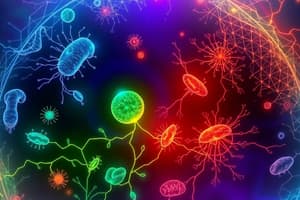Podcast
Questions and Answers
Which of the following must occur for a pathogen to cause disease in humans?
Which of the following must occur for a pathogen to cause disease in humans?
- The pathogen must access a portal of entry, penetrate the surface, and evade the body's defenses. (correct)
- The pathogen must only penetrate the surface to cause disease.
- The pathogen must directly stimulate the adaptive immune response.
- The pathogen must immediately disable the complement system.
What distinguishes the adaptive immune response from the innate immune response?
What distinguishes the adaptive immune response from the innate immune response?
- The adaptive immune response is present at birth.
- The adaptive immune response involves memory and specificity. (correct)
- The adaptive immune response is nonspecific.
- The adaptive immune response is the first line of defense.
Which of the following is an example of the body's first line of defense that provides a structural barrier?
Which of the following is an example of the body's first line of defense that provides a structural barrier?
- Lysozymes in tears.
- Sebum secreted by oil glands.
- Peristalsis in the digestive tract.
- Mucous membranes. (correct)
How do tight junctions between epithelial cells contribute to the body's defense?
How do tight junctions between epithelial cells contribute to the body's defense?
Which of the following is an example of a mechanical barrier in the first line of defense?
Which of the following is an example of a mechanical barrier in the first line of defense?
How does perspiration act as a chemical barrier?
How does perspiration act as a chemical barrier?
What is the significance of 'species specificity' in the context of genetic barriers?
What is the significance of 'species specificity' in the context of genetic barriers?
How do normal flora overcome the body's barriers to establish themselves?
How do normal flora overcome the body's barriers to establish themselves?
Which of the following is the MOST direct example of a genetic barrier to infection?
Which of the following is the MOST direct example of a genetic barrier to infection?
Which event characterizes the second line of defense?
Which event characterizes the second line of defense?
Which of the following components is NOT part of the innate immune response's second line of defense?
Which of the following components is NOT part of the innate immune response's second line of defense?
What is the primary benefit of the inflammatory response?
What is the primary benefit of the inflammatory response?
What is the correct sequence of events that occur following an injury during inflammation?
What is the correct sequence of events that occur following an injury during inflammation?
How does vasodilation contribute to the inflammatory response?
How does vasodilation contribute to the inflammatory response?
What is the advantage of swelling (edema) during inflammation?
What is the advantage of swelling (edema) during inflammation?
Which of the following best describes the role of chemotactic factors in inflammation?
Which of the following best describes the role of chemotactic factors in inflammation?
Which of these processes describes the means by which Neutrophils and Monocytes are delivered to the site of infection, squeezing between the cells of the vessel wall?
Which of these processes describes the means by which Neutrophils and Monocytes are delivered to the site of infection, squeezing between the cells of the vessel wall?
What is the correct order of the five stages of phagocytosis?
What is the correct order of the five stages of phagocytosis?
How does fever contribute to the body's defense?
How does fever contribute to the body's defense?
What is the primary role of interferon in the second line of defense?
What is the primary role of interferon in the second line of defense?
Which of the following BEST describes the function of 'Complement' in the second line of defense?
Which of the following BEST describes the function of 'Complement' in the second line of defense?
What are the primary effects of the complement system?
What are the primary effects of the complement system?
How do surface proteins produced by some microbes interfere with phagocytosis?
How do surface proteins produced by some microbes interfere with phagocytosis?
What triggers the hypothalamus to increase the body's core temperature, resulting in fever?
What triggers the hypothalamus to increase the body's core temperature, resulting in fever?
Flashcards
Innate Immunity
Innate Immunity
The body's initial, broad defense against pathogens, present from birth and nonspecific.
Adaptive Immunity
Adaptive Immunity
A specific immune response that develops over time, creating immunological memory after exposure to an antigen.
Barriers
Barriers
The body's first line of defense that prevents pathogens from entering the body.
Skin
Skin
Signup and view all the flashcards
Mucous membranes
Mucous membranes
Signup and view all the flashcards
Mechanical Barriers
Mechanical Barriers
Signup and view all the flashcards
Chemical Barriers
Chemical Barriers
Signup and view all the flashcards
Genetic Barriers
Genetic Barriers
Signup and view all the flashcards
Adhesins
Adhesins
Signup and view all the flashcards
Second Line of Defense
Second Line of Defense
Signup and view all the flashcards
Inflammation
Inflammation
Signup and view all the flashcards
Vascular Changes
Vascular Changes
Signup and view all the flashcards
Edema
Edema
Signup and view all the flashcards
Neutrophils and monocytes
Neutrophils and monocytes
Signup and view all the flashcards
Chemotaxis
Chemotaxis
Signup and view all the flashcards
Diapedesis
Diapedesis
Signup and view all the flashcards
Phagocytosis
Phagocytosis
Signup and view all the flashcards
Phagosome
Phagosome
Signup and view all the flashcards
Lysosome
Lysosome
Signup and view all the flashcards
Phagolysosome
Phagolysosome
Signup and view all the flashcards
Fever
Fever
Signup and view all the flashcards
Pyrogens
Pyrogens
Signup and view all the flashcards
Interferon
Interferon
Signup and view all the flashcards
Complement System
Complement System
Signup and view all the flashcards
Surface Proteins
Surface Proteins
Signup and view all the flashcards
Study Notes
Overview of Body Defenses
- Numerous pathogens lead to disease in humans
- First, pathogens must access a portal of entry, penetrate the surface, and evade the body's defenses
- Two broad categories of defense are innate and adaptive
- Innate defenses are present at birth and nonspecific, without memory
- Adaptive defenses are specific with memory, developing later in life
- First line of defense includes innate barriers
- Second line of defense is an innate immune response
- Third line of defense is an adaptive immune response
The Body's First Line of Defense
- The surface environment inhibits microbes
- Barriers are non-specific
- Nutrients, temperature, and pH impact the surface environment
- Structural, mechanical, chemical, and genetic factors act as barriers
Structural Barriers
- Epithelium found internally and externally
- Two types of epithelial surfaces are skin and mucous membranes
- Epithelium constantly undergoes mitosis, replacing sloughed layers
- Microbes attached to the epithelium are lost
- Tight junctions exist between epithelial cells
Mechanical Barriers
- Removal with movement
- Mucociliary movement in the nose and throat traps microbes in mucus, cilia coughed/swallowed
- Fluid movement from urine, saliva, and tears flush microbes
Chemical Barriers
- Agents produced by surface cells
- Keratin waterproofs and dries the skin
- Perspiration from sweat glands has salt that inhibits pathogens
- Lysozymes are antibacterial, and found in saliva and tears
- Sebum, from sebaceous (oil) glands, lowers skin pH
- HCL acid lowers stomach pH to inhibit bacteria
Genetic Barriers
- Hosts are genetically immune to other hosts' diseases
- Microbes lack appropriate receptors or the ability to attack host cells
- Species specificity example is HIV versus FIV, Ebola virus, and heartworms
Survival of Normal Flora
- Normal flora survive via adjustments to attach to the surface
- Attachment is with adhesins
- Adhesins bind to complementary receptor molecules via a lock and key fit
Practice Examples
- Salt is an integument chemical barrier
- Lysozymes are a respiratory and chemical barrier
- Mucociliary movement is a respiratory and mechanical barrier
- HCL is a digestive, chemical barrier
- Urine is a urinary, chemical barrier
- Lactobacillus is an epidermis barrier
- Mitosis in the intestine is a structural barrier
- Pinworms are an intestinal, genetic barrier
- Vomiting is a digestive, mechanical barrier
Body's Second Line of Defense
- Occurs when pathogens penetrate skin or mucous membranes, bypassing initial barriers
- Innate and nonspecific immune response
- Involves 4 components: inflammation, phagocytosis, interferon, and complement, with blood involvement
Inflammation
- "Itis"
- Nonspecific response to tissue damage from trauma, wounds, or burns
- Goals are to remove the agent, keep damage local, and allow healing
- Characterized by redness, heat, swelling, and pain
- Fifth sign is loss of function like pain and swelling
Sequential Events Following Injury in Inflammation
- Vascular changes
- Edema (local)
- Fever (systemic)
Vascular Changes
- Triggered by released chemicals, which leads to dilation
- Bradykinins, prostaglandins, and histamine released
- Vasodilation produces redness and localized heat
- Delivers blood clotting proteins and leukocytes to the injury site
Edema
- Swelling
- Results from increased vascular permeability due to the same chemicals
- Increased permeability results in increased pressure from more blood
Consequences of Edema
- Swelling dilutes toxins and applies pressure to nearby nerves
Inflammation
- Vascular changes and edema lead to neutrophils and monocytes delivering to the site of infection
- Chemotactic factors recruit cells
- Diapedesis is when cells squeeze through vessel walls to enter the infection site
- Phagocytosis allows tissue repair and pathogen removal
Phagocytosis
- Cells capable of phagocytosis
- Divided into 5 stages: chemotaxis, ingestion, fusion, killing, and elimination
Phagocytosis Stages
- Chemotaxis is the recognition of the invader
- Ingestion surrounds the microbe and forms a phagosome
- Fusion occurs as a lysosome fuses with a phagosome, creating a phagolysosome
- Killing occurs as digestive enzymes destroy the microbe
- Elimination discharges debris out of cell
Fever
- Only occurs if microbe is present
- Results when systemic pyrogens trigger the hypothalamus, increasing core temperature
- There are bacterial toxins (exogenous) or phagocytes (endogenous)
- Fever makes the environment less hospitable, inhibiting microbe growth and enhancing phagocytosis
Chemical Defenses: Interferon
- Protein molecules released by host cells to inhibit the spread of viral infections nonspecifically
- Inhibits viral reproduction
- A cell releases interferon after infection to protect neighboring cells
Chemical Defenses: Complement
- Serum proteins designated numerically by order of discovery
- Three primary effects: inflammation, opsonization and MAC (cytolysis)
- C3a and C5a: promote inflammation
- C3b: promotes Opsonization
- C5b-9: Promotes MAC/Cytolysis
Interference with Phagocytes
- Microbes produce surface proteins that interfere with direct contact with phagocytes, blocking receptors or mimicking host cells.
- These Surface Proteins allow for the Third Line of Defense
Studying That Suits You
Use AI to generate personalized quizzes and flashcards to suit your learning preferences.




